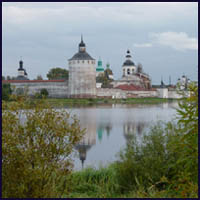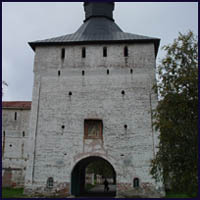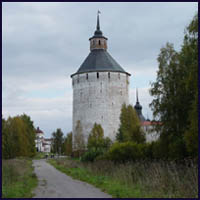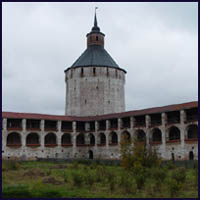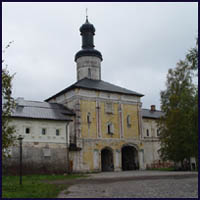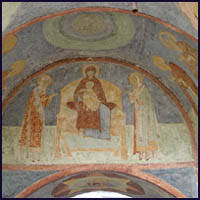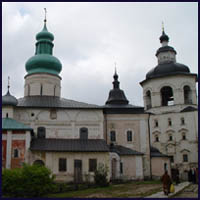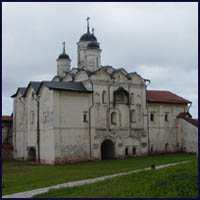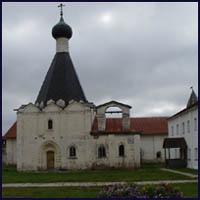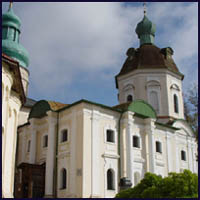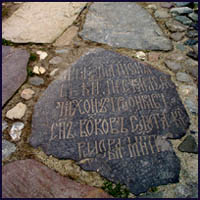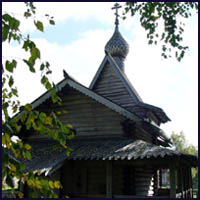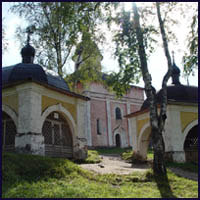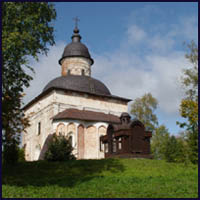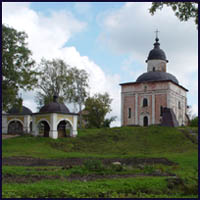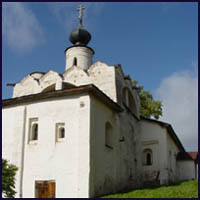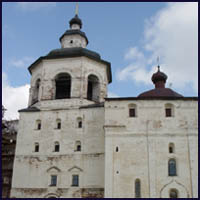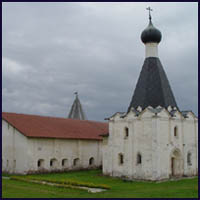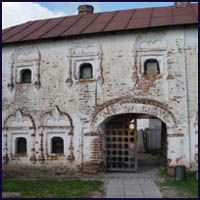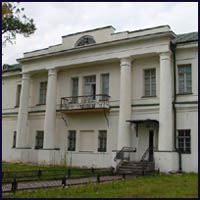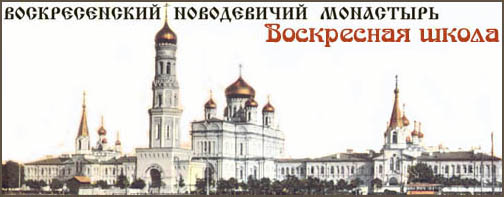|
Kirillo-Belozersky
Monastery was founded in the end of the XIV century. By that time the
Belozerskoye principality, which had separated itself from Rostov
lands in the XIII century, had already lost its independence falling
in the time of Ivan Kalita under Moscow rule, and handed down later to
Dmitry DonskoyТs son Andrey. St.
Kirill called Belozersky, founder of his monastery, descended from the
Veliaminov families, one of the most distinguished Moscow boyar
families, and was earlier a monk at the Moscow Simonov monastery. He
had leaded the Kirillov fraternity for thirty years, until his death.
A prominent member of the Russian Church and not a stranger to earthly
affairs he used hie authority to influence the forming of the State.
The extant letters to Dmitry DonskoyТs sons, Grand Prince Vasiliy,
princes Andrey and Yuriy bear witness to this. Through them Kirill
gives advice to the princes, outlines his idea of princely power.
Highly esteemed by his contemporaries he was sanctified already in the
middle of the XV century. St.KirillТs
active enchancement of the monastery estates was of great importance
for its future. There had been about 40 land acquisitions made by the
monastery in his time; some of them were donations, others were УpurchasesФ.
This energetic growth of the monastery was continued by KirillТs
successors. The
Cathedral of the Dormition, which is the main church of the
Kirillo-Belozersky Monastery, is the central building of the
monasteryТs ensemble. The Cathedral was built in 1497 in the course
of five months (the warm season in this part of the world) by an artel
headed by Master Prokhor from Rostov Great. Subsequently some
alterations were made, affected both the CathedralТs exterior and
interior, but these caused no drastic changes of its architectural
image. In 1554 the Church of St. Vladimir was attached to its northern
wall; it was the burial place of the Vorotynsky princely family. In
1585-1587 a church over St. KirillТs grave was raised on the east
side of the Cathedral in accordance with the will of Ivan the Terrible.
In the 1780s this Church of St.Kirill of Belozersk was
dismantled and replaced by a new one, which still stands on the site. The Cathedral of the Dormition is graced by 17th-century mural painting done by Lyubim Aggev from Yaroslavl Уwith his companionsФ. (Subsequently this same artel painted the murals of the Cathedral of the Dormition in Moscow Kremlin). Ageev
also painted the new porches added to the Cathedral, leaving intact
some of the 16th-century mural works. Because several
churches were later attached to the Cathedral of the Dormition, its
lateral walls acquired wide archways. At the same time that the
porches were painted, another church was built near that of St.
Vladimir: The Church of
St. Epiphanius of Cyprus Ц the burial place of the Telyatevsky
princes. The
Cathedral of the Dormition and the adjoining churches are surrounded
by several buildings, which enclose them on all sides. In 1519 a
refectory hall, one of the largest in Russia, was built on the
southern hillside, complete with the Church of the Presentation of the
Virgin in the Temple. Leaning against one of the refectory walls is a
bell tower built in the17th-18th centuries. Behind it
stands the Church of the Archangel Gabriel (1531-1534). It was raised
at the will of Great Prince Vasily III of Moscow, who visited the
monastery with his second wife Elena Glinskaya to pray for the birth
of an heir. The
outlying eastern part of the monastery grounds has its own cluster of
buildings. Gracefully poised on the hilltop is the Church of St. John
the Baptist Ц the main church of the so-called Maly (minor)
Ioanovsky Monastery, which played an ancillary part to the senior
Uspensky Monastery. The original iconostasis of the Church of St. John
was replaced in the early 19th century by another one,
which had been crafted in the late 18th century for the
Church of St. Kirill. Standing
on the side of the hill that bears the Church of St. John are: on the
northwest slope, a stone ciborium protecting the site of St.
KirillТs earth lodge and the log chapel built by him; on the south
slope, the refectory Church of St. Sergius of Radonezh with a
side-altar dedicated to St. Dionysius Glushitsky, both dated in the
second half of the 16th century. Stone
walls and towers were erected to replace the original wooden walls of
the Uspensky and Maly Ioannovsky Monasteries in the late 16th
century. The so-called Old Town comprised both monasteries, stretching
for 1100 meters. Remnants of these old walls have been preserved on
the southern side facing the lake. One of the towers has a gate known
as the Water Gate because it gives access to a lake cove. In olden
times the main entrance was on this side. In the 16th
century the Church of the Transfiguration was raised over the Water
Gate. Originally it was crowned by three domes. In this church the old
iconostasis has been preserved almost intact. Built
along the opposite northern wall in the 17th century was a
massive structure Ц the Fiscal Chamber; and the northern gate was
crowned by the Church of St. John Climacus. The walls and vaults of
the carriage gate were repainted in 1585 by Уthe Elder AlexanderФ.
The minor archway is graced with the images of all the saints honouredТ
in Belozersk area, including the associates of St. Kirill: St.
Martinian, Therapontos and Paul of Obnora. The major archway features
compositions dedicated to the main altars of the MonasteryТs
churches. Accordingly, the subjects are: the Dormition, the
Presentation of the Virgin in the Temple and the Decapitation of St.
John the Baptist. The main treasure of the Church of St. John Climacus
is its 16th-century iconostasis. In
the 17th century construction projects on the grounds of
the Kirillo-Belozersky Monastery were carried out mostly by local
master builders. In 1643-1644 Yakov Kostousov of Belozersk raised the
hospital building, which was connected with the small tent-domed
Church of St. Euthymius the Great, built in 1646 by the local master
Kirill Serkov. The
year 1653 saw the start of another project: in keeping with a royal
edict tall fortified walls were to be built to enclose the so-called
New Town Ц a territory double that of former walled grounds. This
made Kirillo-Belozersky Monastery the strongest land fortress of
northern Russia. The new walls, enclosing a roughly rectangular
territory, have tall many-faceted corner towers. The finest of these
is the Moskovskaya Tower. The
walls of the New Town brought to an end the building history of this
northern stronghold of the Russian Church. It lost its strategic
importance when Russia gained access to the Baltic Sea; the
secularization of the churchТs landed estates under Catherine II
dealt the final blow to its erstwhile glory. In
the Soviet period the Kirillo-Belozersky Monastery fell on hard days
before it was finally shut down. But it had a happier fate than many
others monasteries: instead of a prison site it became a museum.
Thanks to this many of its art treasures have been saved. |
|
|
The Kirillo-Belozersky Monastery |
|
|
The main Gate |
|
|
Ferapontovskaya (Moscow) Tower |
|
|
Ferapontovskaya (Moscow) Tower |
|
|
View from the Lake. |
|
|
Holy Gates. |
|
|
Holy Gates. |
|
|
Monastery's Ensemble. |
|
|
Church of Transfiguration. |
|
|
Church of St. Euphimius the Great. |
|
|
Church of St. Kirill |
|
|
Stones near St. Kirill's Church. |
|
|
Wooden Church of the Deposition of the Robe (1485). |
|
|
Cannopies over the Chapel of St. Kirill and the Cross of St. Kirill. |
|
|
Church of St. John the Baptist. |
|
|
Church of St. John the Baptist. |
|
|
Church of St. Sergius of Radonezh. |
|
|
Bell-tower and Church of Archengel Gabriel. |
|
|
The Church of St. Euphimius the Great and hospital chamber. |
|
|
Cellar's building. |
|
|
The House of Father Superior. |
|
|
Kazan Church near the Main Gates. |
|
Used literature: |
|
|
|
The Northern Thebaid. Treasures of the Russian Land. Quarterly of the All-Russia Society for the Preservation of Cultural and Historical Treasures. Iss. 30, є3-4, 1993, 192 pp. |
|
|
Kochetkov I.A., Lelekova O.V., Podiapolski S.S. Kirillo-Belozersky and Ferapontov Monasteries. Architectural monuments. "Teza", Moscow, 1994, 64 pp. |
(с) 2003 Sunday School of The Resurrection New Maiden Convent, photo - E.Gusev
